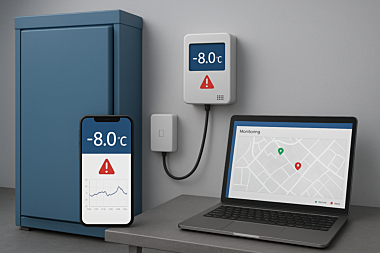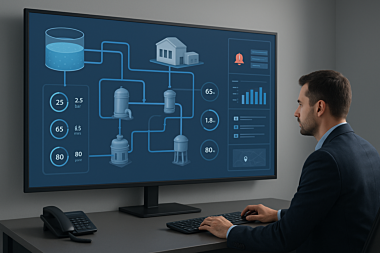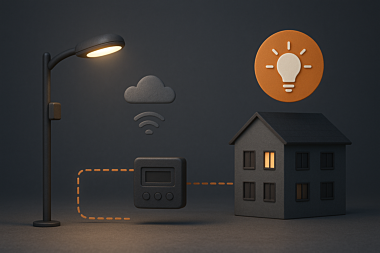Online heat point control: telemetry and energy saving
Remote control of heat distribution units has long ceased to be an ‘option’. Businesses need transparency, quick decisions and measurable results in terms of costs. That is why telemetry is needed: live data, automatic notifications, clear reports. How the system works in practice and why its implementation pays off within the first season.
What is telemetry and why is it necessary for heat distribution units?
The system collects signals from sensors and meters, displays them in a convenient interface, and launches automatic scenarios. Telemetry is about controlling processes without unnecessary trips and making decisions based on facts. The result is lower risks of shutdowns and lower heating and electricity bills.
Telemetry indicators and their significance
Telemetry data provides a complete picture of the condition of the heat distribution unit in real time:
- Supply and return temperatures T1/T2 – monitoring the temperature of the heat distribution unit and adjusting schedules.
- Supply and return line pressure – pressure control in the heat distribution point and accident prevention.
- The consumption indicator provides a clear answer on how to control heat carrier consumption: permissible limits and reports.
- Meter readings – online collection of heat meter readings and online heat energy accounting.
Such monitoring makes it possible to prevent losses and optimise energy consumption.
Telemetry devices: sensors, meters, controllers
The system components are sensors, meters, controllers, communication channels and other components:
- Temperature and pressure sensors, flow meters, pulse inputs.
- Heat meters with M-Bus/Modbus – the basis for metering.
- Controllers for heating systems with Ethernet/GSM.
Together, these tools form a reliable data collection and transmission circuit: sensors record the status, meters provide metering, and controllers with Ethernet/GSM deliver the readings to the dispatching system.
Types of telemetry and data collection methods
There are several approaches, each with its own advantages:
- Local systems with transmission to the server – high response speed.
- Cloud services – quick start and scaling.
- Hybrid – local SCADA plus cloud archive.
Methods – pulses, RTU/TCP, REST. Based on reliable data and flexible telemetry configuration.
Heat point telemetry: parameter control
Online panels show critical values, range, and warnings. This builds confidence in the condition of the nodes and ensures high-quality automation of the heat point. Heat point telemetry minimises ‘blind spots’ and eliminates the need to physically visit facilities to take readings.
Temperature and pressure monitoring:
- Temperature control on supply and return, T1/T2 stabilisation.
- Pressure check at the heat point with emergency limit values.
- Graphs of acceptable ranges and comparison of periods to identify deviations.
Monitoring heat carrier consumption is the key to savings. Advantages:
- Flow meters on main branches, circuit balancing.
- Algorithms for optimising consumption against outside temperature.
- Reports broken down by time windows – see how to control heat carrier consumption at peaks.
Heat distribution point alarms and notifications:
- Overheating, pressure drop, pump failure – heat distribution point alarms.
- Push/SMS/email, Telegram – instant response.
- Clear log of events and responsible persons.
Such control makes it possible to quickly eliminate risks and optimise the operation of the heat distribution point by 20–30%.
Telemetry of heat distribution points for energy saving
Savings start with measurement. When you have reliable data, it's easy to implement weather control, night-time reductions and smart schedules. Practice shows that the combined effect of these measures results in 5–12% savings per season against the backdrop of stable operation of the units – this is how heat distribution point energy saving works.
Online heat energy metering
- Current indicators, archives, error control.
- Convenient reports on buildings, entrances, and buildings — online heat metering without paper.
- Fewer disputes with suppliers.
Control of electricity consumption by heat distribution units
- Metering of electricity for pumps and automation – control of electricity consumption by heat distribution units in terms of units.
- Identification of inefficient modes and overspending.
- Modernisation plans based on data, not guesswork.
Reduced heating costs through automation
- Weather control and night-time reductions.
- Automatic start/stop of circuits outside peak hours.
- Analytics recommendations – reduce heating costs without compromising comfort.
This achieves sustainable energy consumption with minimal risk.
Telemetry: integration and remote access
Systems operate longer and more stably when they have open interfaces, monitoring and updates. Remote access to the heat distribution point provides 24/7 control, and APIs simplify data transfer to adjacent platforms. This is online heat distribution point control.
SCADA system and web interface
SCADA provides centralised management and data visualisation for effective dispatching.
- Visualisation of nodes, trends, user roles – a heat distribution point dispatching system with transparent rights.
- Web office from a laptop or phone.
- Backup and change log.
This interface simplifies daily monitoring and increases data security.
Remote monitoring and control of the heat distribution point
Remote access allows you to respond quickly to events from any device without being physically present.
- Remote monitoring of the heat distribution point from mobile devices.
- Commands to equipment, energy saving scenarios.
- Automatic restart of processes after failures.
This minimises downtime and optimises resources in real time.
Integration with ERP and dispatch systems
Integration combines telemetry with corporate systems for seamless data exchange.
- API/CSV/JSON – exchange of archives and events.
- Automatic reports to accounting and operations.
- A single dashboard for the entire building network.
This approach automates reporting and facilitates strategic planning.
How telemetry works: a practical example
We see the maximum effect in real-life cases. The ITP system reduces response time and simplifies accounting. Implementation pays off faster when there is reliable equipment for monitoring ITP and a well-thought-out architecture.
Installation of a digital temperature control relay
- A digital temperature control relay stabilises circuits and increases reliability.
- Suitable for Ethernet and GSM.
- Provides accurate temperature control at critical points.
Automatic data collection and archiving
- Sensor readings, meters, events – automatic collection of readings without human intervention.
- Daily/weekly/monthly reports.
- Season-to-season analytics.
RPM-416 recorder at the heat distribution point
- The recorder receives signals, keeps a log, and sends events.
- Ethernet/GSM, Modbus RTU/TCP, MQTT/HTTPS – compatibility with SCADA.
- Convenient channel for collecting readings from the heat meter online and further processing.
Telemetry ITP provides transparent online control of the heat distribution point: live readings, deviation alerts, automatic reports. Reduces downtime and costs, increases energy efficiency without compromising comfort. Open interfaces, Ethernet/GSM and SCADA ensure integration and scalability. To connect the system, start with an audit, select sensors and a controller, set thresholds and get a controllable, economical and predictable heat distribution point.



